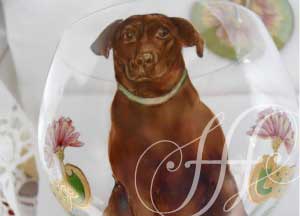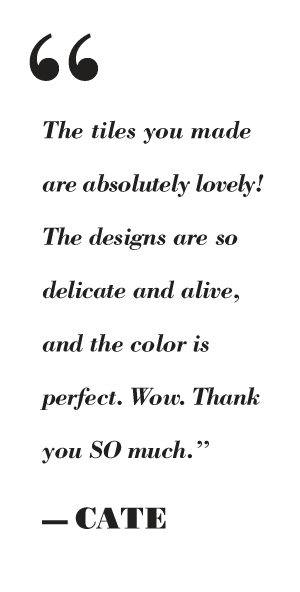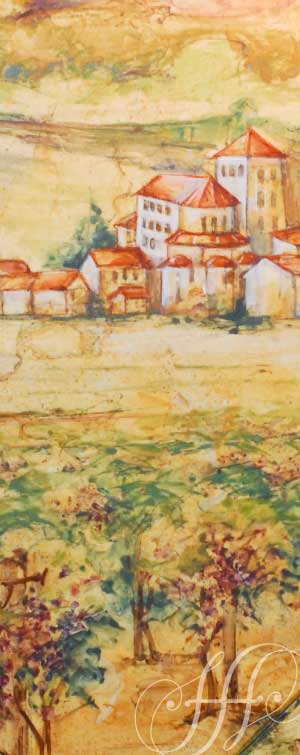Tiles: ceramic, porcelain, stone, and glass. Please note: Tile cannot be painted in place. Individual tiles must be painted and fired in her studio before installation. Stone tile cannot be fired. It may be painted and sealed for durability and permanency.
Bath fixtures: vitreous porcelain sinks (pedestal or drop in), toilet tank lids, and faucet handles. Please note: These items must be free of metal and be purchased directly from a plumbing supply house. They must be brand new (out of the box).
Accessories: porcelain wastebaskets, tissue box holders, cabinet knobs, switch plates, soap dishes, and bath cups.
Decorative and useful items: porcelain bowls, vases, lamp bases, trays, platters, pitchers, umbrella stands, and tile house number signs.
Glass: bowls, vases, stemware, platters, painted inserts for stained glass cabinet doors and windows.
The process begins with a meeting to discuss your ideas, favorite interests, life style, and home surroundings. Sharon takes the time to evaluate your surroundings and get to know you. She works with you to help decide subject matter, or decide if a favorite interest, activity, or personal story with meaningful details may be utilized in your custom piece. She can meet with you in your home, on location, or at the tile store. A viewing of her complete portfolio is available upon request.
Who wouldn't be thrilled with a gift that stands apart from the rest as a treasure created especially for you? All Sharon needs to know is a favorite interest, animal, theme, or occasion to bring your idea to life. Popular pieces include personalized pairs of painted crystal stemware or other glass styles, vases, or any shape porcelain piece. Custom designed house numbers are also available.
Large-scale installations start with accurate measurements of your space. Sharon works with you to choose what type of material (tile or stone) best suits your needs. Bringing samples of your countertop, cabinets, floor, and wall colors allows her to harmonize and integrate your space and personal taste fully into the piece.
For tile installations, grout joint breaks are planned in advance. Sharon will work closely with you or your tile contractor to help you determine what works best.
Next a pencil design is created to size. The line drawing provides a good model of what the finished piece will look like and allows you to be comfortable with the design direction. Depending on the location, the drawing may be tacked in place for design approval.
Jobs vary in turnaround time, depending on their complexity. Independent decorative pieces, such as wine glasses, may take as little as 2 weeks. Larger murals or installations may take longer.
For all installations, each piece (either mural part or independent deco) is numbered and labeled on its backside, at the top. A diagram is provided for ease of installation. A helpful map, the diagram shows the intended spot for each piece, allowing you to easily reassemble the tile on site.
The porcelain and glass painting process is done on finished blank pieces. Pieces need to be brought to the studio for painting and firing.
Dry powdered pigments made from minerals and ground glass are mixed with oil to form a paste consistency and painted with soft natural-hair brushes. During firing the paint becomes translucent and will take on the tonality of the original surface. This process ultimately lends a glass like finish to the piece.
Paint is applied in multiple, thin, and smooth applications then kiln-fired. The process of kiln-firing transforms the paint into a permanent part of the piece. Porcelain painted pieces generally need three or more fires to develop the maximum depth of color, form, and detail.
Firing temperatures range from 1100º F to 1500º F depending on the piece. Every additional process of painting and kiln-firing builds on the last, producing a beautifully saturated tonality and depth of shading. The result is a deep rich shine that is permanent with normal care.
All ceramic, porcelain, and glass pieces are kiln-fired for durability and permanency. All stone pieces are painted and sealed for durability and permanency.
Use only gentle and non-abrasive cleaners and warm water. Dry with a soft cloth. Do not use harsh chemicals or acidic cleaners that might break the finish.
Painted porcelain pieces may go into the dishwasher.
Painted glass should be hand washed and dried.
Painted stone should be cleaned with a soft cloth and gentle cleaner.
The art of kiln-fired painting has its roots in the history of early China. In about 600 AD, it was discovered that combinations of kaolin clay and felspar resulted in beautiful, high quality porcelain.
Porcelain is distinguished from other ceramics because of it's hardness, translucency, and whiteness of body. It has subtle differences depending on the variances in minerals and clay found at the extraction site. In early times it was even thought of as white gold.
In the 18th Century, the decoration of porcelain became as important as the item itself. Each factory had a staff of artists who developed styles specific to their location. French artists mostly painted portraits and landscape scenes on miniature boxes and cups. Italians artists were known for painted figurines, flowers, and village scenes.
Porcelain production became so expensive, that by the latter part of the 18th Century, all porcelain was designed for either aristocrats or royalty. The Industrial Revolution caused many European porcelain artists to lose their jobs, as less costly, mass-produced objects gained popularity.
Wilder Austin Pickard (1857-1939) was largely responsible for bringing the art form to the United States. He established Pickard China in 1893. They offered many hand-painted items and specialized in decorating dessert and tea sets. He provided jobs for many displaced European artists. He created a uniquely American style of hand-painted china and developed his own recipes for manufacturing blank plates and glazes.
In recent years, as new materials and techniques have developed, an exciting group of artists with an independent spirit are pushing the boundaries of traditional kiln-fired arts. While integrating its historical beginnings on simple domestic objects, you can also find kiln-fired paintings in museums, fine art galleries, and in stunning interior designs. They are integrating art with every day life, elevating the art form, and inspiring a new generation.






